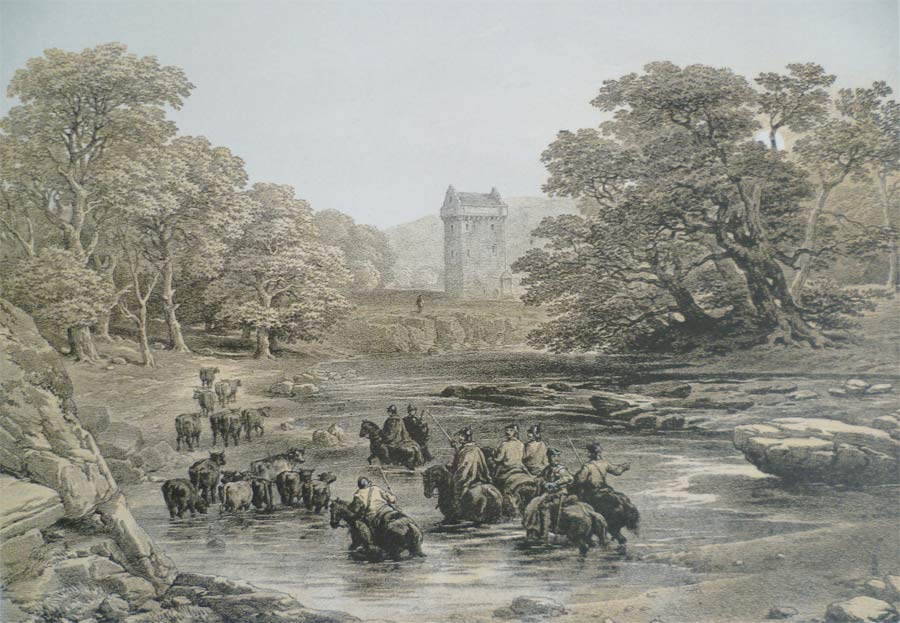WordPress database error: [Got error 28 from storage engine]
SELECT t.*, tt.*, tr.object_id FROM wp_terms AS t INNER JOIN wp_term_taxonomy AS tt ON tt.term_id = t.term_id INNER JOIN wp_term_relationships AS tr ON tr.term_taxonomy_id = tt.term_taxonomy_id WHERE tt.taxonomy IN ('category', 'post_tag', 'post_format') AND tr.object_id IN (853, 1461, 1676, 1776, 2091, 2498, 5711, 5726, 60746, 61476) ORDER BY t.name ASC
Clan Armstrong History
The Armstrongs are a significant border clan whose origins lie in Cumberland, south of the frontier between Scotland and England that was officially established in 1237. The Armstrong name alledgedly has a mythological origin, in that it is said their heroic progenitor, Fairbairn, saves his king of Scotland in battle, and not from a wild beast as is the case with another Border clan – the Turnbulls.
It is said that, dressed in full armour, he lifted the king onto his own horse with one arm after the King’s horse had been killed under him in battle. The family crest records this act of heroism that was to be rewarded with a grant of lands in the Borders and the famous Armstrong name.
The first specific reference locating them in Liddesdale, which would become their family seat, is in 1376. Liddesdale was also the seat of their unquestioned power in the region that allowed them to expand into Annandale and Eskdale to accommodate their growing population. It is reputed that by 1528 they were able to put 3000 horsemen in the field.
The Armstrongs’ relationship with subsequent Scottish kings was turbulent to say the least. The most notorious event in this uneasy relationship occurred in 1530. John Armstrong, known in history as ‘Gilnockie’, was persuaded to attend a meeting at Carlingrigg with King James V who, unknown to Gilnockie, had the malicious intent to silence the rebellious Borderers. The ruse succeeded as Gilnockie and fifty followers were captured.
The Royal order to hang them was issued and despite several pleas for the King to be lenient in exchange for obedience, it was carried out. Defiant to the last, Gilnockie said these words directly to King James V:
“I am but a fool to seek grace at a graceless face, but had I known you would have taken me this day, I would have lived in the Borders despite King Harry and you both.” His defiance is commemorated and echoed in the soulful popular Border ballad, “Johnie Armstrong”:
“Farewell! my bonny Gilnock Hall
Where on Esk side thou standest stout !
Gif I had lived but seven yeirs mair
I wad a gilt thee round about
John Murdered was at Carlinrigg
And all his gallant companie;
But Scotland’s heart was ne’er sae wae
To see sae mony brave men die.”
In 1587 an act was passed by the Scottish parliament “for the quieting and keeping in obediance of the inhabitants of the Borders, Highland and Isles …” That contained a roll of Chieftains and clans that confirms the status of Border families as an important part of clan history, and the Armstrongs as perhaps the most significant Border clan.
The clan’s authority resided intact at Mangerton in Liddesdale, a succession of Armstrongs retaining the ‘Laird of Mangerton’ title, until 1610 when Archibald Armstrong was ‘put to the horn’ as a rebel.
After this, the Armstrong lands passed into the hands of the Scotts.
Clan Armstrong Posts
Quick Links to Clan Armstrong Products from The Clan Shop
- Armstrong Tartan Tie
- Armstrong Tartan Pocket Square Handkerchief
- Armstrong Tartan Scarves
- Armstrong Tartan Kilts
- Armstrong Clan Crest Badge
- Armstrong Clan Crest Mug
- Armstrong Clan Crest T-Shirts
- Armstrong Clan Crest Belt Buckle
- Armstrong Phone Covers
- Armstrong Tartan
- Armstrong Clan Crest Crystal Glasses
- Armstrong Clan Crest Cufflinks
- Armstrong Clan Crest Sgain Dubh
- Armstrong Clan Crest Kilt Pin
- Armstrong Clan Crest Plaques


















